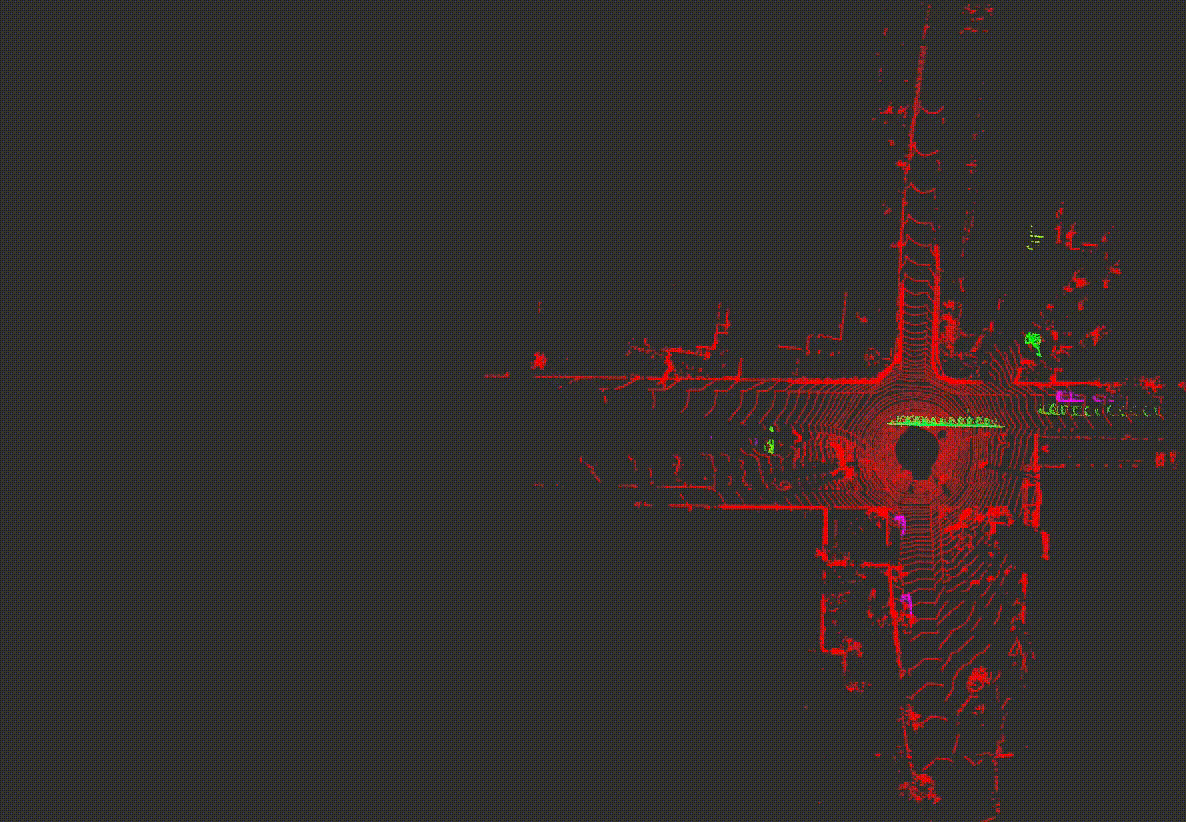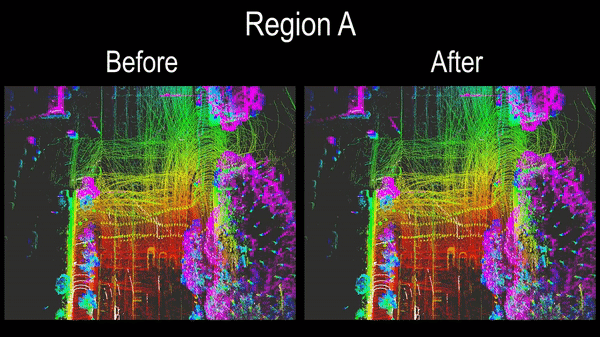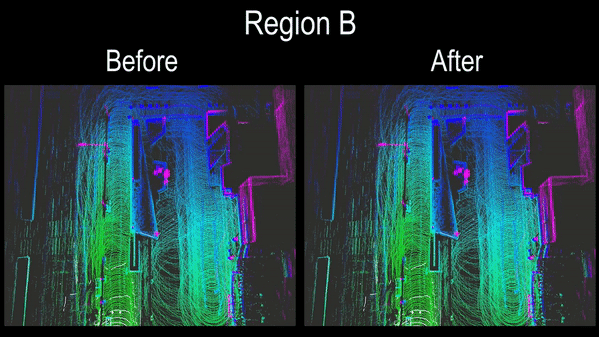Official page of "ERASOR: Egocentric Ratio of Pseudo Occupancy-based Dynamic Object Removal for Static 3D Point Cloud Map Building", which is accepted by RA-L with ICRA'21 option [Video] [Preprint Paper]
We provide all contents including
- Source code of ERASOR
- All outputs of the State-of-the-arts
- Visualization
- Calculation code of Preservation Rate/Rejection Rate
So enjoy our codes! :)
Contact: Hyungtae Lim (shapelimatkaistdotacdotkr)
Advisor: Hyun Myung (hmyungatkaistdotacdotkr)
- An example of running ERASOR in your own env. is provided.
- Please refer to please refer to
src/offline_map_updater/main_in_your_env.cppandlaunch/run_erasor_in_your_env_vel16.launch. The more details are here.
- Please refer to please refer to
- Test Env.
- Requirements
- How to Run ERASOR
- Calculate PR/RR
- Benchmark
- Visualization of All the State-of-the-arts
- ERASOR in the Wild
- Citation
The code is tested successfully at
- Linux 18.04 LTS
- ROS Melodic
- Install ROS on a machine.
- Also, jsk-visualization is required to visualize Scan Ratio Test (SRT) status.
sudo apt-get install ros-melodic-jsk-recognition
sudo apt-get install ros-melodic-jsk-common-msgs
sudo apt-get install ros-melodic-jsk-rviz-plugins- Thereafter, compile this package. We use catkin tools,
mkdir -p ~/catkin_ws/src
cd ~/catkin_ws/src
git clone https://github.com/LimHyungTae/ERASOR.git
cd .. && catkin build erasor - Our metric calculation for PR/RR code is implemented by python2.7
- To run the python code, following pakages are necessary: pypcd, tqdm, scikit-learn, and tabulate
pip install pypcd
pip install tqdm
pip install scikit-learn
pip install tabulate- Download the preprocessed KITTI data encoded into rosbag.
- The downloading process might take five minutes or so. All rosbags requires total 2.3G of storage space
wget https://urserver.kaist.ac.kr/publicdata/erasor/rosbag/00_4390_to_4530_w_interval_2_node.bag
wget https://urserver.kaist.ac.kr/publicdata/erasor/rosbag/01_150_to_250_w_interval_1_node.bag
wget https://urserver.kaist.ac.kr/publicdata/erasor/rosbag/02_860_to_950_w_interval_2_node.bag
wget https://urserver.kaist.ac.kr/publicdata/erasor/rosbag/05_2350_to_2670_w_interval_2_node.bag
wget https://urserver.kaist.ac.kr/publicdata/erasor/rosbag/07_630_to_820_w_interval_2_node.bag- Please note that the rosbag consists of
node. Refer tomsg/node.msg. - Note that each label of the point is assigned in
intensityfor the sake of convenience. - And we set the following classes are dynamic classes:
# 252: "moving-car"
# 253: "moving-bicyclist"
# 254: "moving-person"
# 255: "moving-motorcyclist"
# 256: "moving-on-rails"
# 257: "moving-bus"
# 258: "moving-truck"
# 259: "moving-other-vehicle"
- Please refer to
std::vector<int> DYNAMIC_CLASSESin our code :).
We will explain how to run our code on seq 05 of the KITTI dataset as an example.
Step 1. Build naive map
- Set the following parameters in
launch/mapgen.launch.target_rosbag: The name of target rosbag, e.g.05_2350_to_2670_w_interval_2_node.bagsave_path: The path where the naively accumulated map is saved.
- Launch mapgen.launch and play corresponding rosbag on the other bash as follows:
roscore # (Optional)
roslaunch erasor mapgen.launch
rosbag play 05_2350_to_2670_w_interval_2_node.bag- Then, dense map and voxelized map are auto-saved at the
save path. Note that the dense map is used for evaluation to fill corresponding labels. The voxelized map will be an input of step 2 as a naively accumulated map.
-
Set the following parameters in
config/seq_05.yaml.initial_map_path: The path of naively accumulated mapsave_path: The path where the filtered static map is saved.
-
Run the following command for each bash.
roscore # (Optional)
roslaunch erasor run_erasor.launch target_seq:="05"
rosbag play 05_2350_to_2670_w_interval_2_node.bagNews (22.03.01): The submap module is employed to speed up when extracing map VOI.
Plase check the below rosparams in run_erasor.launch:
<rosparam param="/large_scale/is_large_scale">true</rosparam>
<rosparam param="/large_scale/submap_size">160.0</rosparam>
Note that appropriate submap_size is > 2 * max_range.
- IMPORTANT: After finishing running ERASOR, run the following command to save the static map as a pcd file on another bash.
- "0.2" denotes voxelization size.
rostopic pub /saveflag std_msgs/Float32 "data: 0.2"- Then, you can see the printed command as follows:
- The results will be saved under the
save_pathfolder, i.e.$save_path$/05_result.pcd.
You can check our results directly.
- First, download all pcd materials.
wget https://urserver.kaist.ac.kr/publicdata/erasor/erasor_paper_pcds.zip
unzip erasor_paper_pcds.zipThen, run the analysis code as follows:
python analysis.py --gt $GT_PCD_PATH$ --est $EST_PCD_PATH$E.g,
python analysis.py --gt /home/shapelim/erasor_paper_pcds/gt/05_voxel_0_2.pcd --est /home/shapelim/erasor_paper_pcds/estimate/05_ERASOR.pcdNOTE: For estimating PR/RR, more dense pcd file, which is generated in the mapgen.launch procedure, is better to estimate PR/RR precisely.
-
Error metrics are a little bit different from those in the paper:
Seq. PR [%] RR [%] 00 91.72 97.00 01 91.93 94.63 02 81.08 99.11 05 86.98 97.88 07 92.00 98.33 -
But we provide all pcd files! Don't worry. See Visualization of All the State-of-the-arts Section.
- First, download all pcd materials.
wget https://urserver.kaist.ac.kr/publicdata/erasor/erasor_paper_pcds.zip
unzip erasor_paper_pcds.zip-
Set parameters in
config/viz_params.yamlcorrectlyabs_dir: The absolute directory of pcd directoryseq: Target sequence (00, 01, 02, 05, or 07)
-
After setting the parameters, launch following command:
roslaunch erasor compare_results.launch- Then you can inspect all pcd results that are already parsed into static points and dynamic points.
- All examples are here:
To check generalization of ERASOR, we tested ERASOR in more crowded environments. In that experiment, Velodyne Puck 16 was employed, and poses are estimated by LIO-SAM.
| Satellite map | Pcd map by LIO-SAM |
|---|---|
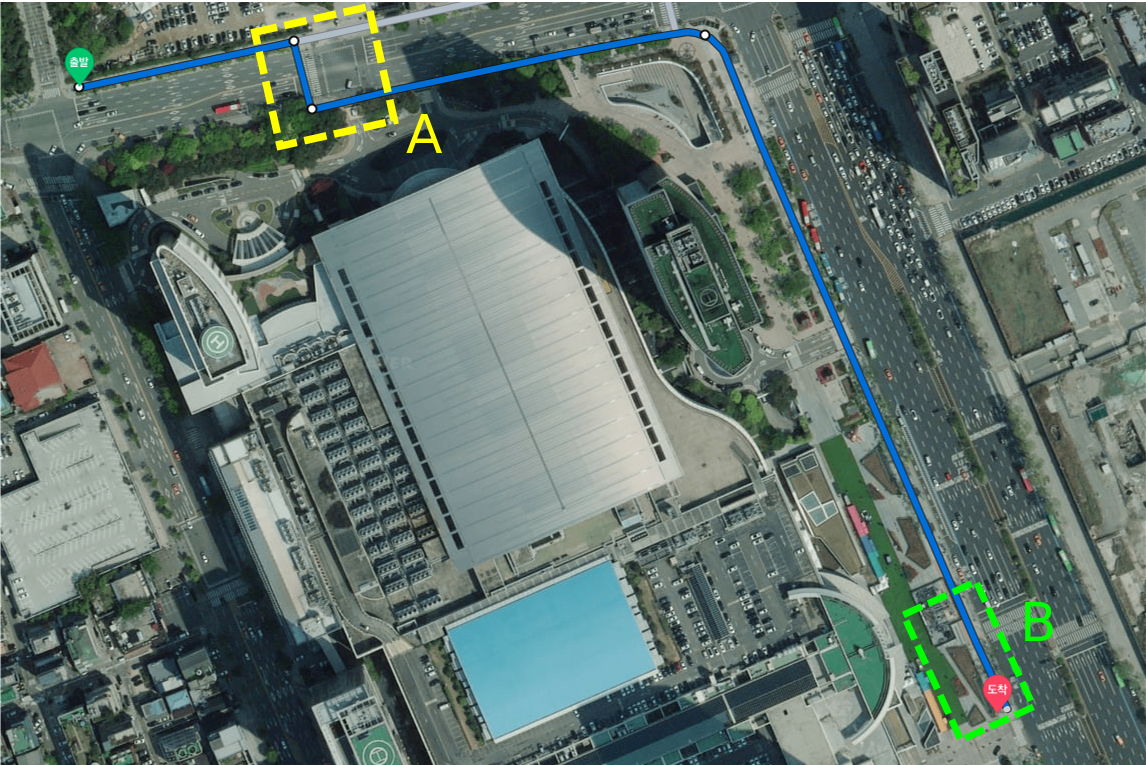 |
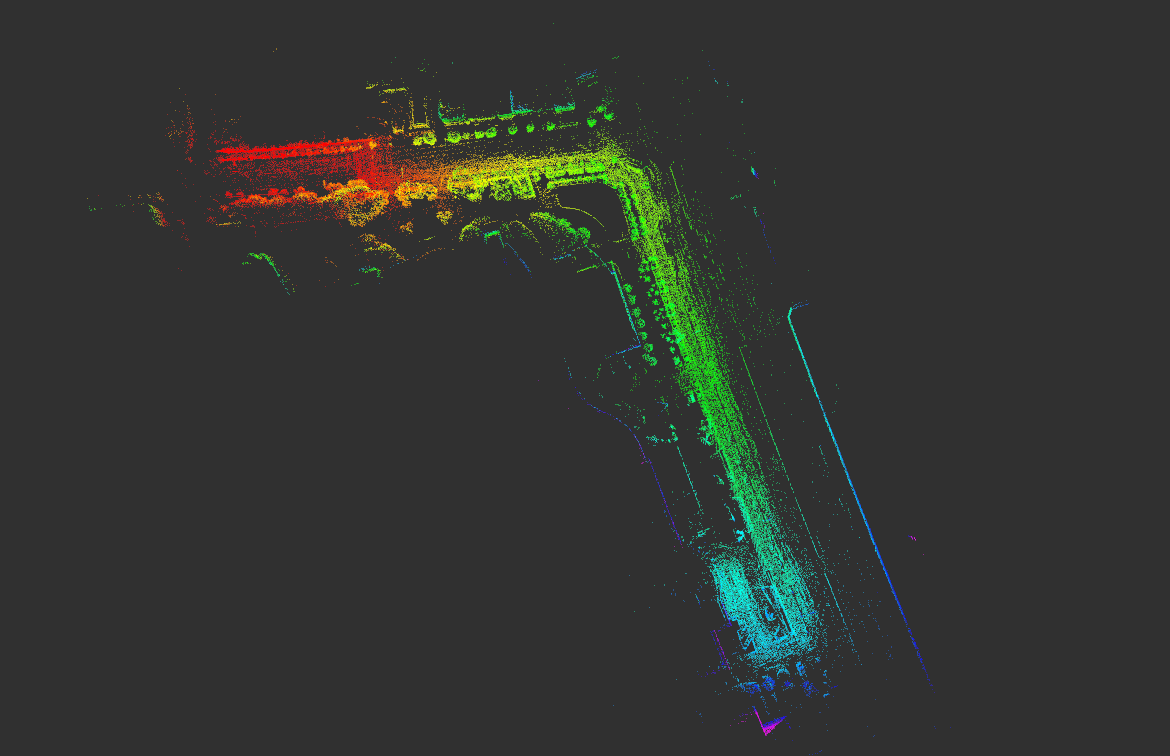 |
When running ERASOR in your own environments, please refer to src/offline_map_updater/main_in_your_env.cpp file and launch/run_erasor_in_your_env_vel16.launch.
You can learn how to set experimental setting by repeating our pre-set configurations. Please follow our instructions.
- First, download pre-set dataset.
wget https://urserver.kaist.ac.kr/publicdata/erasor/bongeunsa_dataset.zip
unzip bongeunsa_dataset.zip
- Modify
data_dir,MapUpdater/initial_map_path, andMapUpdater/save_pathinconfig/your_own_env_vel16.yamlto be right directory for your machine, wheredata_dirshould consist of following components as follows:
`data_dir`
_____pcds
|___000000.pcd
|___000001.pcd
|___000002.pcd
|...
_____dense_global_map.pcd
_____poses_lidar2body.csv
_____...
- Next, launch
launch/run_erasor_in_your_env_vel16.launchas follows:
roslaunch erasor run_erasor_in_your_env_vel16.launch
- As shown in
config, depending on your own sensor configuration, parameters must be changed. In particular,min_handmax_h, andth_bin_max_hshould be changed (note thatmin_handmax_h, andth_bin_max_his w.r.t. your body frame of a query pcd file.) - If you use a low-channel LiDAR sensor such as Velodyne Puck-16,
max_randnum_ringsmust be set as smaller values likeconfig/your_own_env_vel16.yamlto guarantee the estimated normal vector for each bin is considered to be orthogonal to the ground. - If too many points are considered as ground points for each bin, then reduce the value of
gf_dist_thr.
If you use our code or method in your work, please consider citing the following:
@article{lim2021erasor,
title={ERASOR: Egocentric Ratio of Pseudo Occupancy-Based Dynamic Object Removal for Static 3D Point Cloud Map Building},
author={Lim, Hyungtae and Hwang, Sungwon and Myung, Hyun},
journal={IEEE Robotics and Automation Letters},
volume={6},
number={2},
pages={2272--2279},
year={2021},
publisher={IEEE}
}

